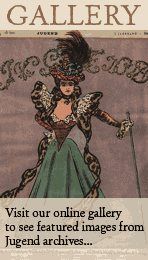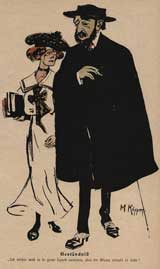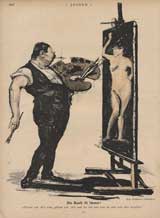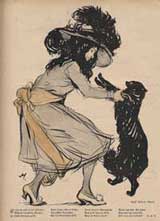Frequently Asked Questions
Did Jugend influence the Nazis in any way?
Like most magazines in the time of Nazi Germany, the pages of Jugend were turned largely into propaganda for the Nazi party after 1933. Some draw a link between Jugend and the later naturalist/spiritualist movement that contributed to the development of Nazism, but this is a tenuous link at best, and certainly Jugend can't be held at fault for this.
Perhaps the most influence Jugend had was in infuriating Nazis. In its pages were nurtured a number of young artists who later became thorns in the collective Nazi side, people they deemed corrupt because of their art or their thoughts. Jugend and Georg Hirth had made these young artists confident in their own work, and they held as much contempt for the Nazis as they were held in contempt. Unfortunately for Germany and the world, contempt has never been a great weapon for stopping oppression, and these artists were killed, silenced, or fled the German countries entirely.
Alas also for Jugend, that the Hitler Youth were named in such a similar manner: Hitler Jugend. For the record, the two have nothing whatsoever to do with one another.
How were Jugend and psychology related?
It is possible that Jugend was an influence on Freud and Jung, who were both interested in many of the same subjects as the readers of Jugend, but it's more likely that both the publication and the scientists were influenced by many of the same factors that were floating around Germany at the time.
The turn of the century in Europe was a time of great change and flux everywhere. In France, scientists like the Curies were making amazing discoveries in the physical properties of nature. Throughout Europe, the ideas of Charles Darwin were slowly beating back those who wanted a more religious view to be predominant (and, incidentally, contributing to social Darwinism and ultimately, tragically, the Nazi idea of a Master Race).
In Germany and the German-speaking countries, the predominant science turned out to be psychology, the study of how people think. Freud invented psychotherapy, and Jung blended Freud's methods with the spiritualist and symbolic ideas in society, art, and literature in his time to create the collection of ideas ultimately called Jungian psychology. He blended science and art, just as the artists of the day were doing, to find something larger and more transcendental than either.
In the end, there is little way to be certain. Something was in the air at the turn of the century, and it influenced everything: art, politics, psychology, science, literature, and society in general. Because the writers and artists of Jugend were highly literate and well-read, it's almost certain they were well-informed of the psychological ideas of symbolism; it's also very likely, however, that they were also simply siblings developing from many of the same roots.






